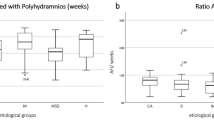Abstract
OBJECTIVE:
Occasionally, clinicians are presented with a complicated preterm pregnancy where fetal pulmonary maturity testing might be used to help guide management decisions. However, should delivery be allowed if the lecithin to sphingomyelin ratio (L/S ratio) is not quite mature? The incidence of newborn complications after delivery with L/S ratio values of 1.8 and 1.9 is unknown. The purpose of this study was to evaluate the neonatal morbidity and mortality in patients that delivered with these borderline immature results.
STUDY DESIGN:
All patients who underwent fetal pulmonary maturity testing were prospectively recorded in log books. An L/S ratio of ≥2.0 was considered mature. Patients with an L/S ratio of 1.8 or 1.9 were considered “borderline immature.” These borderline immature cases were evaluated for the gestational age at amniocentesis, the gestational age at delivery, and neonatal outcome.
RESULTS:
During the 9-year study period, L/S ratio testing was performed on 2038 patients. Of these, 162 preterm patients (7.9%) had an L/S ratio of 1.8 or 1.9. A total of 63 of these 162 patients delivered <72 hours after the amniocentesis and met study criteria. The pregnancies ranged from 27 to 36 weeks’ gestation. There was a 13% incidence (95% confidence interval (CI) of 4% to 30%) of major neonatal morbidity and a 3% incidence (95% CI of 0% to 17%) of neonatal mortality in the 30 pregnancies with an L/S ratio of 1.8. The incidence of major neonatal morbidity was only 3% (95% CI of 0% to 15%) in the 33 patients with an L/S ratio of 1.9, with no cases of mortality (95% CI of 0% to 9%).
CONCLUSION: Based on 95% CIs, the data of this study reveal that the maximum risk for major morbidity is ≤15%, with a mortality risk of <10% in a preterm newborn delivered with a 1.9 L/S ratio value. The maximum risk is 30% for major morbidity and 17% for mortality in preterm newborns delivered with a 1.8 L/S ratio. This information may help in the decision-making process of whether to deliver or to observe when faced with a borderline immature L/S ratio result in a complicated preterm pregnancy.
This is a preview of subscription content, access via your institution
Access options
Subscribe to this journal
Receive 12 print issues and online access
$259.00 per year
only $21.58 per issue
Buy this article
- Purchase on Springer Link
- Instant access to full article PDF
Prices may be subject to local taxes which are calculated during checkout
Similar content being viewed by others
Author information
Authors and Affiliations
Additional information
This study was performed at Long Beach Memorial Women’s Hospital. Preliminary information from this study was presented at the 1995 Annual Clinical Meeting of the American College of Obstetricians and Gynecologists.
Rights and permissions
About this article
Cite this article
Burkhart, A., Towers, C., Rumney, P. et al. Neonatal Outcome When Delivery Follows a Borderline Immature Lecithin to Sphingomyelin Ratio. J Perinatol 20, 157–160 (2000). https://doi.org/10.1038/sj.jp.7200331
Published:
Issue Date:
DOI: https://doi.org/10.1038/sj.jp.7200331
This article is cited by
-
Effects of di-(2-ethylhexyl)-phthalate and its metabolites on the lipid profiling in rat HRP-1 trophoblast cells
Archives of Toxicology (2006)



